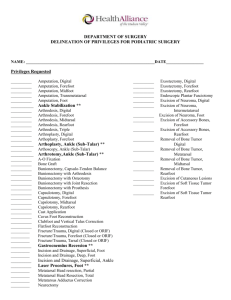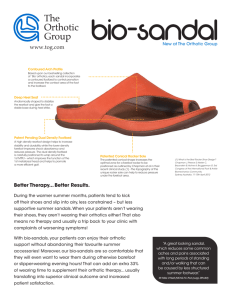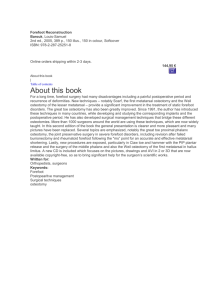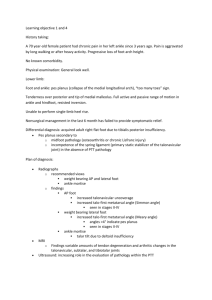Foot and Ankle Biomechanics
advertisement
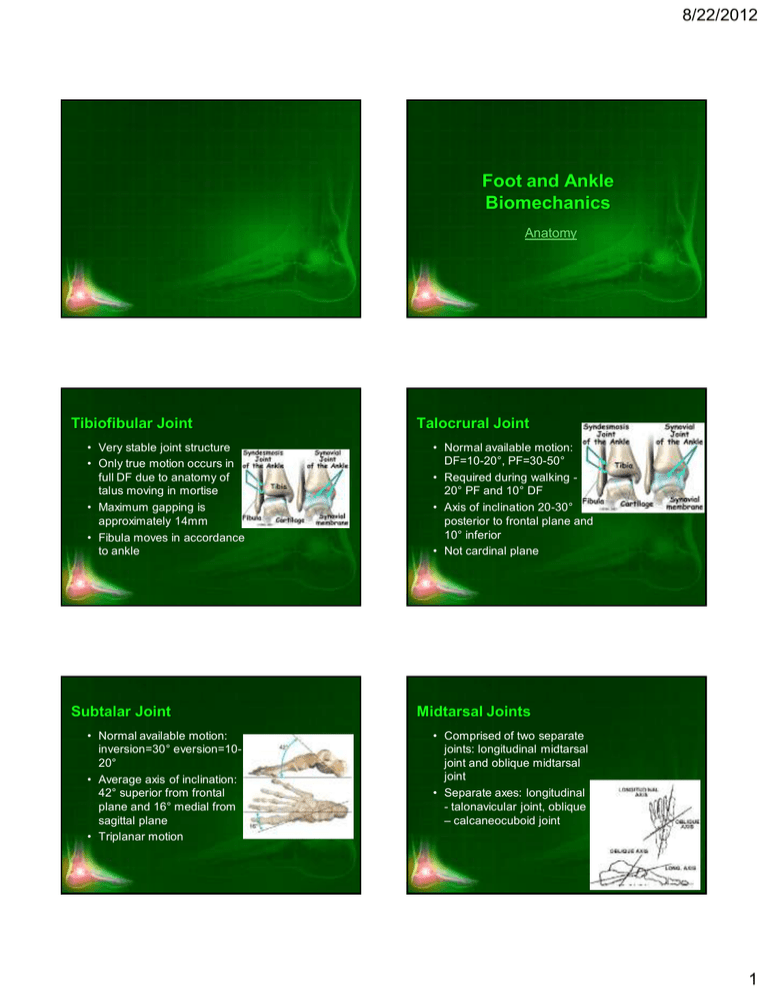
8/22/2012 Foot and Ankle Biomechanics Anatomy Tibiofibular Joint • Very stable joint structure • Only true motion occurs in full DF due to anatomy of talus moving in mortise • Maximum gapping is approximately 14mm • Fibula moves in accordance to ankle Subtalar Joint • Normal available motion: inversion=30° eversion=1020° • Average axis of inclination: 42° superior from frontal plane and 16° medial from sagittal plane • Triplanar motion Talocrural Joint • Normal available motion: DF=10-20°, PF=30-50° • Required during walking 20° PF and 10° DF • Axis of inclination 20-30° posterior to frontal plane and 10° inferior • Not cardinal plane Midtarsal Joints • Comprised of two separate joints: longitudinal midtarsal joint and oblique midtarsal joint • Separate axes: longitudinal - talonavicular joint, oblique – calcaneocuboid joint 1 8/22/2012 Midtarsal Joints Midtarsal Joints Longitudinal Midtarsal Joint Oblique Midtarsal Joint • Axis= 15° from transverse plane, 75° from frontal and 9° from sagittal planes • Axis= 52° from the transverse plane, 57° from the sagittal plane and 38° from the frontal plane • Primary motion – inversion and eversion • Alignment of midtarsal joint axes are a result of subtalar influence. • Pronation of STJ causes MTJA to become more parallel allowing greater fore foot motion • Motion – DF and ABD; PF and ADD First Ray • Comprises the first metatarsal, medial cuneiform, navicular • Axis of motion: posterior/dorsal/medial to anterior/plantar/lateral. 45° from the sagittal and frontal planes • Motion occurs in 2 planes simultaneously: • Dorsiflexion and inversion • Plantarflexion and eversion Plantar Fascia • Attaches primarily from the medial calcaneal tuberosity to the base of the proximal phalanges • Acts as a truss and beam system – windlass effect Other Support Structures • 4 layers of intrinsic muscles • 19 extrinsic muscles (long tendons) Biomechanics and Alignment • Approximately 107 ligaments 2 8/22/2012 Normal Alignment • Open chain: calcaneal bisection comparison to lower 1/3 of leg is 0-2° inverted • Closed chain: both plantar condyles and metatarsal heads are in the same plane and positioned on support surface Rearfoot Varus • Calcaneus is inverted with respect to the lower leg • Considered by some to be the most common osseus foot deformity • 3 types: compensated, partially compensated and uncompensated Tibial Varum • Curvature or bowing of the tibia in the frontal plane places the hindfoot in an inverted position in relation to the supporting surface • Up to 4° is considered normal. 4-7° is notable. 8° or more is pathological. Normal Alignment • Normal amounts of pronation occur (4-6°) • From posterior view, calcaneus is either rectus or slightly everted • Amount of normal pronation is different in children under age 7, = (7-age+ 4-6°) Rearfoot Valgus • Hindfoot is everted when held in subtalar joint neutral • Extremely rare – probably wrong – measure it again • Assess for contributing pathology Forefoot Varus • Medial aspect of the forefoot • Some consider is inverted in relation to the forefoot varus lateral aspect of the forefoot. to be most common deformity of the • Also inverted in relation to foot. the rearfoot (at level of midtarsal joint) 3 8/22/2012 Forefoot Varus Forefoot Valgus • Medial aspect of the forefoot is everted in relation to the lateral aspect of the forefoot • Forefoot is everted in relation to plantar condyles of the calcaneus Forefoot Valgus • Flexible forefoot valgus – the midtarsal joint has sufficient flexibility to allow the lateral column of the foot to reach the floor • Calcaneus is vertical in weightbearing Forefoot Supinatus • Soft tissue deformity of forefoot Plantarflexed First Ray • Rigid forefoot valgus – rigid midtarsal joint does not allow the lateral column to reach the ground subsequently the subtalar joint supinates to compensate. • First Ray = first metatarsal + first cuneiform + Navicular • Plantar aspect of the first ray is inferior to the plane of 2 nd – 5th metatarsals • Similar appearance to forefoot valgus if rigid • If flexible, functions similar to forefoot varus, looks like a neutral foot. Ankle Equinus • Maximum dorsiflexion is less than 10° • Produces requirements of over-pronation • Same appearance as forefoot varus • Consequence of long term over-pronation • Motion is required of oblique midtarsal joint • Creates early heel off • Increased energy expenditure during ambulation 4 8/22/2012 Forefoot Equinus • Forefoot is in plantigrade with respect to the rearfoot Hallux Limitus • Great toe extension at the MTP joint is less than 70° in open chain and less than 30° in closed chain • May be structural or functional limitation Hallux Rigidus • Great toe extension at first MTP joint is less than 30° in open chain or less than 10° in closed chain • Typically a structural limitation Hallux Abductovalgus • Medial deviation of the great toe at the level of the MTP • Typically see widening of the space between the first and second metatarsal shafts Hallux Primus Elevatus • Dorsal first ray hypermobility • In weight bearing, first ray is forced dorsally secondary to instability and ground reaction forces Metatarsus Adductus • Medial deviation of all five metatarsal shafts • Produces the appearance of a curved shaped foot. • One part of a bunion formation 5 8/22/2012 Evaluation Process • Analyze gait, noting main abnormalities Biomechanical Evaluation Process • Gain an impression of lower extremity function as a whole through functional screening • Measure/assess objective data • Put the pieces of the puzzle together Functional Evaluation • Perform in order to maximize patient comfort • Use information to formulate a functional hypothesis and compare to actual function Prone Evaluation • Compare available motion vs motion utilized • Carefully bisect the posterior calcaneus and distal limb first • Don’t split hairs – if all does not correlate then NOTHING IS Prone Evaluation – Lab Activities • Bisect distal leg and posterior heel • Measure available inversion • Measure available eversion • Find subtalar joint neutral • In STJN, measure leg rearfoot relationship • In STJN, measure rearfoot to forefoot relationship • Measure DF/PF with knee flexion and • Passive inversion available • Passive eversion available • STNJ position (rearfoot and forefoot) • Talar head congruency • Passive DF from inversion to eversion • Dorsiflexion (gross ROM and in STJN with knee flexed and extended) • Assess extrinsic and intrinsic muscle strength (gross strength and isolated strength) • All performed in ‘Figure 4’ position or in hip neutral Supine Evaluation • Utilized to determine leg length inequalities • Measured from ASIS to medial malleolus and umbilicus to medial malleolus. Average over 3 trials. Recorded in cm. • Must first clear the pelvis to assess leg length differences. • Measure malleolar torsion • With femoral condyles in neutral, palpate malleoli, measure the plane of the axis • Norms: 18-23° of external rotation 6 8/22/2012 Supine Evaluation – Lab Activities Supine Evaluation • Measure midtarsal joint integrity • LMTJA: with rearfoot in supination, assess the flexibility of medial midfoot invert and evert • OMTJA: with rearfoot in supination, assess flexibility of lateral midfoot to dorsiflex/abduct and plantarflex and adduct • Measure great toe ROM into extension Standing Evaluation • Resting Calcaneal Stance Position – provides information on self selected foot postures • Patients frequent subtalar joint position Heel Rise Test • Used to demonstrate posterior tibial function • Rated as normal inversion, partial inversion, unable to perform/eversion. Rate height of elevation as well. • Must compare to noninvolved side if applicable. • Leg length assessment • Visual inspection in supine and sitting • Measure ASIS to medial malleolus • Measure umbilicus to medial malleolus • Midtarsal joint integrity • LMTJ • OMTJ • Great toe ROM • Malleolar Torsion • Femoral condyles neutral • Measure axis Pronation/Supination Test • Half Squat – provides information on maximum pronated position • Mimics loading response and early midstnace positions during gait • Gives information on foots effect on kinetic chain • Quick screen utilized to determine the flexibility of the subtalar joint • Gait cycle requires pronation from ground up and supination from the hip down • Grossly measured as excessive, adequate, inadequate Tibial Angle • Measured posteriorly from bisection of distal limb and a known angle • Provides information on contributions of proximal structures on foot function • Greater than 4° is excessive, greater than 8° is pathological 7 8/22/2012 Axis of Inclination Navicular Drop Test • Used to predict suspected amount of subtalar motion that is normal for the individual • Measures frontal plane motion of calcaneus to transverse plane motion of talus • Measures magnitude the navicular tuberosity drops from a non-weight bearing position to a weight bearing position • Average for normal is 7-8° • High axis = 2-4° of suspected eversion at maximum pronation, average axis = 4-6° of eversion, low axis = 6-8° of eversion Standing Evaluation Lab Activities • Measure RCSP • Resting calcaneal stance position – leg to rearfoot • Measure ½ squat position • Leg to rearfoot • Measure tibial angle • Leg to floor • Assess axis of inclination • High, normal, low • Assess • Pronation/supinati on test • Excessive motion, normal motion, insufficient motion • Assess heel rise test • Full ROM? • Calcaneal inversion? • Navicular Drop test • Seated height • Standing height 8
